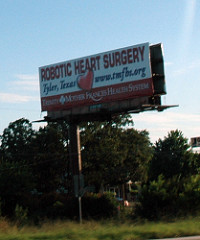
Robotic Heart Surgery Billboard (Photo credit: Marshall Astor – Food Fetishist)
Barron’s recently profiled Intuitive Surgical, maker of the da Vinci Surgical System. The article was standard high quality work characteristic of the publication. (Though today’s focus is not on investment quality, the phrase “120 inch trocar” comes to mind when considering a company trading at twice the market multiple in an environment of slowing growth).
Robotic surgery is an important innovation, but has not yet proven to be a game-changing technology. Though fascinating and impressive, robotic surgery hasn’t duplicated the impact seen in the laparoscopic revolution.
When laparoscopy emerged, gallbladder removal with a big incision and days in the hospital was replaced with several small cuts and an overnight stay; with a clearly shorter recovery (albeit with an increase in duct injuries until the procedure was mastered). Other operations were soon improved using laparoscopy, with shorter hospital stays and lower complications.
The benefits of robot-assisted prostatectomies and hysterectomies continue to be debated by researchers. But the technology is here, and it factors prominently in hospitals’ marketing efforts and clinical programs.
Robotic surgery has higher costs, roughly $2000 per case, but this is not paid by government or private insurers. The costs are borne by hospitals, which hope to recoup them via capturing additional market share both in the robotic clinical areas as well as additional ones via increased exposure. Institutional reputations may improve with public perception as a high-tech clinical destination.
Right or wrong, the public tends to equate higher-technology care with better care, and it is generally easier to embrace this concept (get the robot) than try and resist and wait for research-proven superiority to be determined. Residency programs also face a recruiting disadvantage without the latest technology.
Even in freer market areas such as cosmetic surgery, higher-tech is preferred to lower-tech – laser liposuction is a recent example, despite unproven benefits. So even if patients paid the marginal cost of robotic surgery, it would still be opted for in most cases.
Despite hospitals absorbing the additional cost of robotic surgery, those capturing additional market share have not yet demonstrated lower costs. And in the distorted healthcare market, such reductions are not likely to be seen unless hospitals are pressured by competitors, patients shoulder more of the cost, or payors take action (with the latter often the least-effective).
In taking on the additional cost of robotic surgery, hospitals assume some degree of risk and participate in another area of technological competition, the so-called ‘medical arms race’. Should the additional costs not produce the desired results, other clinical programs and staff may bear the fallout. But with additional clinical areas to be explored, it seems a reasonable risk. If eventually the robot demonstrates open-to-laparoscopic-gallbladder improvement in some clinical area, it will be well worth it.
Read the Barron’s recent profile here.

